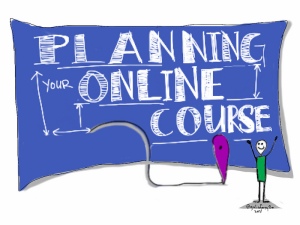
graphic by Giulia Forsythe
Discussion boards are a critical tool for online learning environments. Often times, they are the only tool that faculty use to facilitate student-student interaction, and even faculty-student interactions. In asynchronous courses especially, this tools plays a significant role in building a sense of community.
Unfortunately, more often than not, discussion boards, or blogs, fall short of engaging students in the kind of interaction they would experience in a face-to-face setting. Not because it’s not possible, but because the discussion prompts are boring or poorly designed.
In order for online course discussion boards to be successful, a few factors come into play: 1) the question prompt is ho-hum (a regurgitation of the readings), 2) the willingness of the student to participate and connect with others through the discussion board 3) the discussion timeline. If any of these factors are amiss, student participation may seem rather drab.
So, this back to school season, revise your plan for discussion prompts. Think well beyond open-ended questions. Purposefully design discussion assignments with the learner experience at the center and as a result you, and your students, will experience the benefits of a growing course community.
Here are some ways to do that:
- Challenge your students to do something new, as Jill Rooney suggests: require students to respond to a prompt about the material from a different point of view – a character in the story, the author, an onlooker, etc.
- Incorporate video, audio or articles into the prompt. This often helps to keep students’ attention and provide a greater context for learning concepts.
- Ask them to argue the opposite side, as is done in debate courses. You may even consider dividing the students into groups (or teams) representing either side of the debated topic.
- Could you incorporate a game into the discussion board assignment? For example, Rooney also suggests designing a “telephone” style discussion board prompt that enables students to add-on the storyboard of another student.
- Use a real life scenario from the news and ask students to apply course concepts to the real life scenario.
- For courses that involved projects, require peer critiques. This will force student-student interaction that both engages critical thinking skills and fosters personal relationships among students.
- For a more advanced course, consider making students a part of the discussion board prompt. On a rotating basis, designate a student facilitator who is charged with leading the discussion that week. Dr. Sarah Eaton has shared a very helpful 1-page document on tips for facilitating online discussions.
Finally, to help build community further, consider designing social presence activities as well as curriculum/learning focused activities. Give students an opportunity to interact with each other without the formal framework of an assignment. Allow them to get to know each other and you. FacultyFocus’ article, “Tips for Building Social Presence in Your Online Class” is a good place to start.